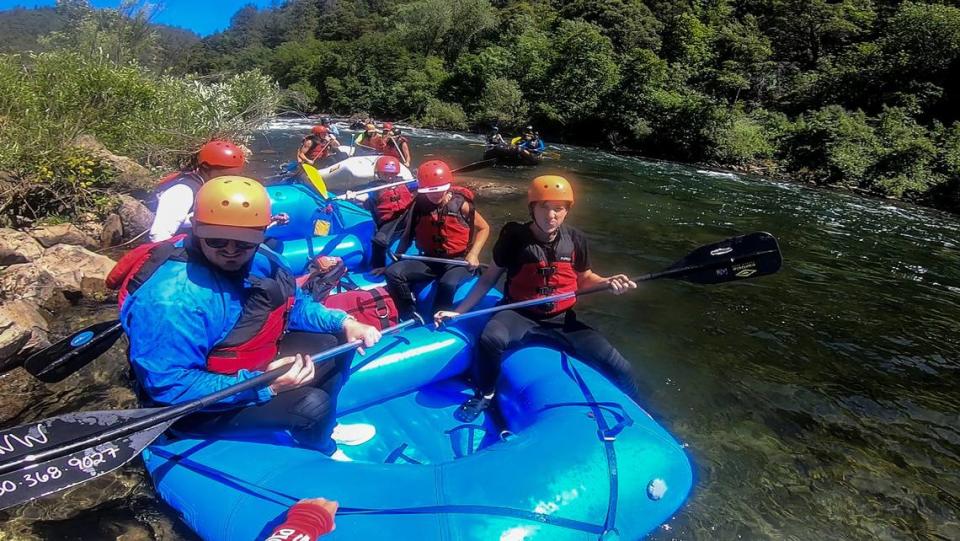We brave whitewater rafting on idyllic Northern California river. Watch us fall overboard
Gliding over smooth rocks seen through clear waters can be serene.
But that serenity dissipates when the rocks pass by faster — and the roar of what’s ahead gets louder. Eventually the calming site of the rocks beneath the blue boat is replaced by choppy rapids. And the adrenaline starts to kick in when you’re asked to paddle forward, as hard as you can, without knowing what’s coming.
That kick is largely what keeps avid whitewater rafters coming back. It’s also what makes the three forks of the American River in the Sierra, roughly an hour east of Sacramento in the Auburn State Recreation Area, one of the best places in the country for the novice and seasoned to get their whitewater rafting fix. It’s a benefit of living in Sacramento for outdoor enthusiasts, particularly those wanting to get away from triple-digit temperatures in the summer.
The snow fall over the past winter wasn’t as the same level as the record breaking ski season in 2022-23, but the 423 inches of snow recorded by Palisades Tahoe was second most of the past five years. This gives the American River and its reservoirs plenty of snow melt for whitewater rafting season which typically booms from May until school is back in session in September.
“These are some of the best whitewater rafting areas on the planet,” said Deric Rothe, the owner and operator of the Sierra Whitewater rafting company. “So if you live in this area, why not?”
Last Chance ahead
We moved down the Middle Fork of the American River on warm day in May. Ahead was a Class IV rapid, aptly named Last Chance, which must be navigated perfectly because of what follows.
Joe Jester, our guide for the day implored the rafters the first of our four-raft contingent, “Forward! Hard!” He trusted paddlers to be in sync so the boat can be steered toward the right line amid chaos.

Minutes earlier, during a pre-trip safety briefing, the guide discussed the importance of the paddling in unison. Doing so allows the boat to go straight as efficiently as possible. After some practice over calm waters to get the pacing down, we were ready to start down the river for 18 miles.
“Rafting is the ultimate team sport,” Jester said. “So when everyone paddles at the same time, at the same amount force, then the boat will just drive forward very consistently. That’s easy to control.
“In reality, there’s slightly different times in which people paddle ... So as the guide, you’re constantly adjusting for that to keep the boat straight,” he said.

Which takes us back to Last Chance. The boat was powered by five largely inexperienced rafters, including two journalists sitting up front tasked with setting the pace for the others to replicate. The adrenaline was high, and the focus on Jester’s instructions was higher.
The rafters weren’t prepared for trying to row in rhythm over the choppy rapids. Protruding rocks, the raft bouncing through waves, the river’s cacophony drowning out the guide’s voice, and the momentary shock of ice cold water splashing faces; everything jarred senses when precision was key.
Jester called it a “domino effect.” The flow of the water through the rocks meant Last Chance had to be hit at the perfect angle to set up the boat for the biggest rapid of the day coming seconds later.
That’s the famous rapid known as Tunnel Chute — a roughly a 12-foot drop through a small window not much wider than the raft itself. It’s a class IV or V rapid, depending whom you ask. The descent kicked boats toward the aptly-named Magnetic Rock on the right side of the shoot and then immediately left when the drop came. The harsh rapids leading into the fall forced the guide to instruct the riders toward the middle of the boat for safety, which meant no more paddling and minimal control.
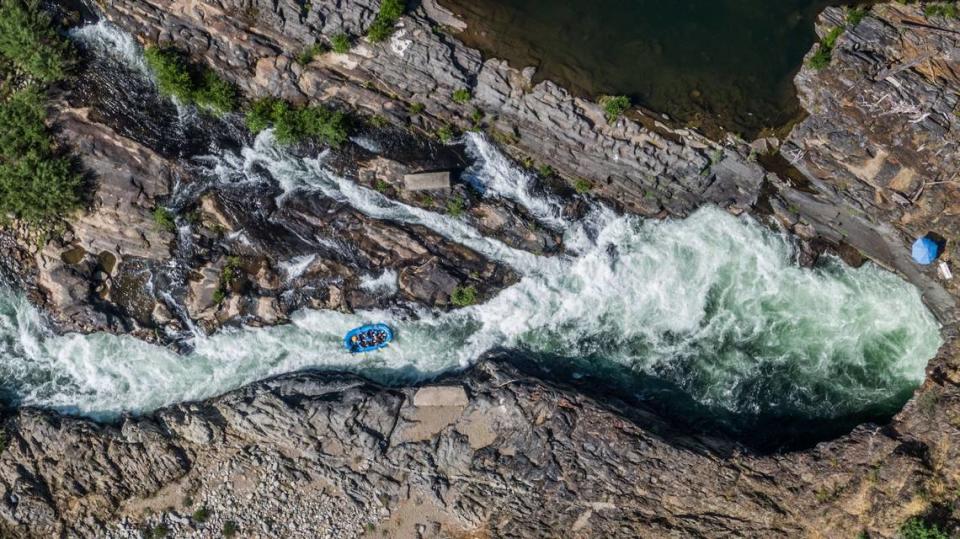
To no one’s surprise, the paddling on our boat leading into the Tunnel Chute wasn’t exactly precise, and the two journalists sitting up front, dictating the pace, were ejected into the water after hitting Magnetic Rock on the right side of the rapid, tipping the boat left.
Hector Amezcua, our visual journalist on the assignment, was rafting for the first time. He was in the front right side of the boat, experiencing one of the most famous and treacherous rapids in California roughly 20 minutes into his rafting career.
“The first thing is panic,” Amezcua said of falling in the river.
Before putting the boats in the water, Jester had given Amezcua, myself and our three other crew members a 20-minute safety briefing. The key instructions for anyone who fell out: Stay calm and try to go downstream on your back allowing the life jacket to keep you afloat.
But nothing can prepare you for being jolted out of the raft if it’s never happened to you before.
“You just don’t know, and you’re out of your element,” Amezcua said. “You don’t have any control. The water’s rushing and you don’t know which way is up and which way is down. I looked up and I saw this white light, and I was like, ‘oh my goodness, this is it!’
“And then I realized, ‘oh, it’s just water bubbles.’”
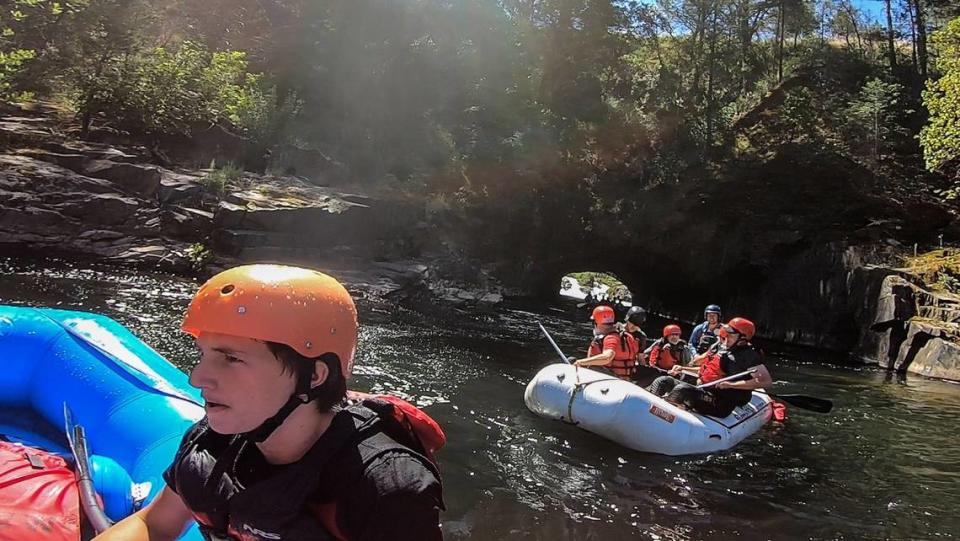
The American River’s different options
American River’s three forks offer three different experiences.
The North Fork is a favorite among purists. The water from the river comes directly from the snow melt in the Sierra while the flows for the Middle and South forks are controlled by upstream reservoirs. The flow from the North Fork is natural.
Which means its season is earlier and shorter than the others. The snow typically melts in April or May, making spring the best time to raft when temperatures are often colder. The river is highest when warm weather comes soon after the snow, leading to the snow melting quickly to fill up the river.
“I would say my favorite is the North Fork,” Jester said. “Without a dam upstream of it, that makes it just a very pristine, beautiful river. And it’s more of a special thing because it’s more rare. To have good flows on the North Fork is something that only comes a couple of times a year.”
The North Fork is still running, Rothe said. Though it likely won’t last beyond the next week or two, which is considered later than usual. The Sierra experienced a relatively late snow season this year with some ski resorts staying open through mid April. The North Fork’s calling card is the slew of Class IV rapids coming in the first hour of the trip, while rapids among the other forks are more spread out.
“On the North Fork, it’s more of a continuous, fast moving water through the sections which does make it a little bit more unpredictable and exciting,” Jester said.
The South Fork features Class II and III rapids and is considered the best option for children or seniors. It’s the most popular among families. The South and Middle forks are open all summer and into the fall until the weather changes. The season typically dies down when kids go back to school.
The Middle Fork was reshaped by the gold rush of the 1800s, which was apparent throughout the trip.
For example, the Tunnel Chute was made by miners who wanted to divert the river to find gold. They used dynamite to blast a hole through the side of a mountain, sending the river through the tunnel. It dried out a bend in the river making finding the precious metal easier. The ordeal unintentionally created a rapid that’s become one of the most famous in the area.
Steel pipes and pillars over 100 years old protrude from the side hills and canyons next to the river. The giant rocks that create Ruck-a-Chucky Falls dropped into the river after gold miners blew up the side of the neighboring mountain with explosives. The falls are a portage where the civilians climb out of the boat and watch their guides navigate a 20-foot drop on their own before hopping back in.
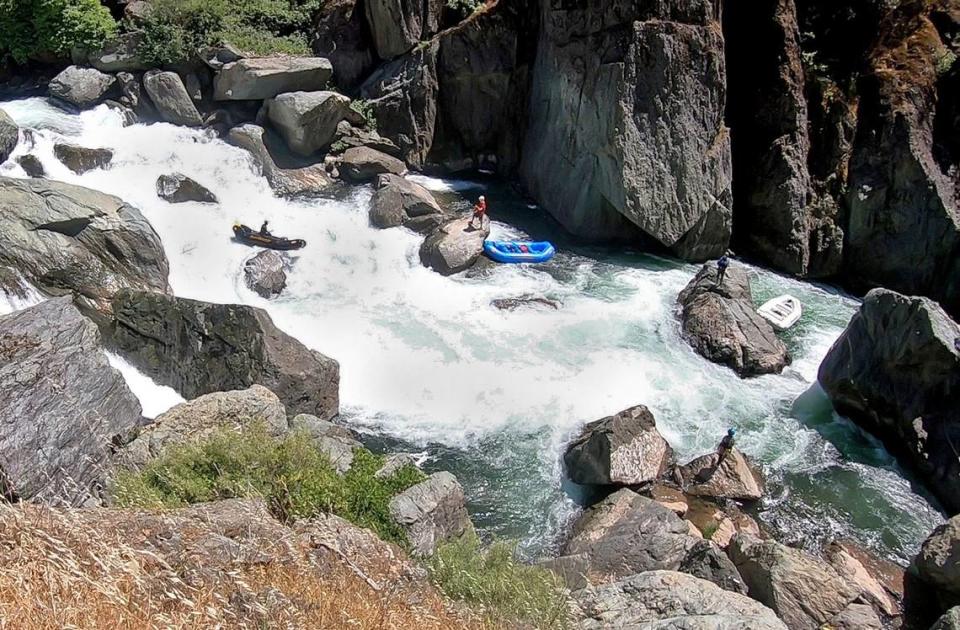
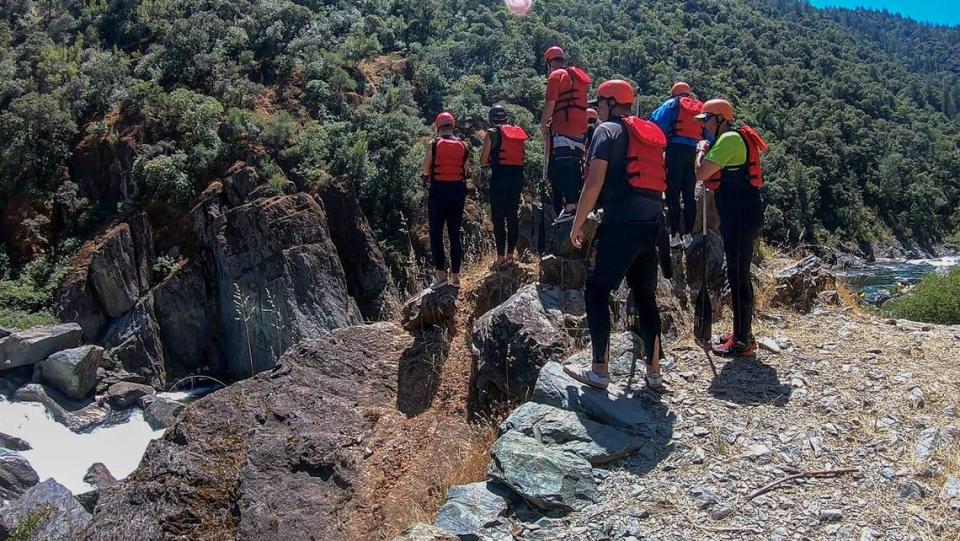
Then come rapids called Cleavage, because boats must fit between a pair of like-sized rocks, and Parallel Parking, which requires the raft to bounce off a rock wall and back through the second part of the rapid. Navigating all of it is a testament to the skill of the guides, particularly while working with inexperienced paddlers serving as the boat’s engine.
Late in the trip, giant cement pillars and concrete from one of the four fallen bridges from the Hell Hole Dam’s failure in December 1964 can be seen sitting at the bottom of the river. We saw a bald eagle fly in front of us and perch on a tree during the calm portion of our trip.
Otherwise, the appeal of the Middle Fork is the combination of all it provides, including exciting and intense rapids, highlighted by Tunnel Chute. We saw no roads or signs of civilization beyond a couple welcomed bathrooms built by California State Parks by our lunch stop.
It’s a serene getaway from phones and computer screens.
“You get out on the river and you’re with nature, you’re breathing clean air, you’ve got this fresh, cool water coming at you and you are in the moment,” Rothe said. “The only thing you’re thinking of is the next rapid. And it just brings a sense of calm to your body.”
A hobby of thousands
Rothe said Sierra Whitewater had roughly 6,000 guests last summer following the historic rainfall of the previous winter season. This year’s wasn’t quite as robust, but there was still plenty of snow pack to keep the North Fork running into June and the reservoirs full filling the Middle and South forks.
“The conditions for whitewhatever rafting are ideal,” Rothe said. “In late April, early May, we got some big snow storms and now all that’s melting and coming down. The reservoirs are full and the rivers are just perfect. It would be considered a normal year as far as precipitation goes, but normal after many years of drought is awesome.”
Lauren Shoemaker, the sector superintendent of the Auburn State Recreation Area, said the interest in whitewater rafting in the American River has risen in line with the growth in tourism throughout state recreational and wilderness areas since the pandemic.
She said the Placer County Water Agency will be doing recreational water releases out of the Oxbow Reservoir six days week to control flows on the Middle Fork, and that the reservoir is slightly less full than last year when there was historic snowfall in the Sierra.
“Doing proper research before people head out, knowing their own abilities, recognizing the abilities between quick moving water and stagnant water, and some of the hazards that those entail are all recommendations that we put out there to the public,” Shoemaker said. “And a big statement we always make to everyone, is if you’re near water, we recommend everyone wear a life jacket.”
A full day on the Middle Fork with Sierra Whitewater runs roughly $169 per person before taxes and fees. Lunch and transportation to the starting and end points is included. Wet suits can be rented for $10 each. A half day on the South Fork is $139.
Oars, a nation-wide rafting company, offers trips on all three forks ranging from $145 for Youth on the South Fork to $209 for adults on the Middle Fork.
Some guidance
Rafters have a lot to consider when planning a trip.
They can choose from 10 to 12 rafting companies in the area. The three forks offer unique experiences, with the North considered the most challenging, the Middle being a mix of challenging and family friendly, and the South the best for children and seniors.
“I usually recommend the (South Fork) because it’s kinda perfect for everyone,” Rothe said. “It’s got some really fun rapids. The first few rapids are Class I and II. So if you haven’t done a lot of rafting, you can get your paddling strokes down. You learn how to sit in the raft and get comfortable before you start hitting the bigger rapids.”
Jester said he leads rafting trips five or six days a week during the busy season. Sierra Whitewater will have 10 to 20 instructors working seasonally and trips often include four or five boats at a time.

Despite falling out of the boat and feeling a moment of uncertainty, Amezcua came away from his experience with a new perspective on whitewater rafting and what it takes for guides successfully and safely lead a trip.
“I think that’s just one of the wonderful things of going in that organized fashion that way,” Amezcua said, “because you have people who are experts on the river and they know what they’re doing as opposed to going with your buddies.”
Sierra Whitewater guides are trained in CPR and water rescue while some are certified EMTs. First-aid equipment is brought on each trip. Rothe said in his 17 years of owning the company it has never had serious injuries or had to file an insurance claim. His company, and others, provide wet suits, water jackets, life jackets and helmets. Lunch was also provided roughly halfway through our trip.
Rothe suggests those going white water rafting wear sneakers that can get wet or sandals with a heel strap. But the most important thing when planning for a whitewater rafting trip is doing the necessary research. Also important: sunscreen, sunglasses (and straps to keep them latched to your head).
“First, go with a professional outfitter,” Rothe said. “Read reviews, people tell a story. So you want to go with somebody who takes it seriously. Every river should be respected. If the guides or the company don’t respect the river, that’s a red flag.”
Eighteen miles, six hours, a slew of Class IVs and an unexpected hurling out of the boat courtesy of the area’s most famous rapid, the respect for whitewater rafting down the American River was unquestionably earned.
My plunge
My experience was a little different than Amezcua’s. From the perspective of the left side of the front of the boat, it felt as though the entire thing flipped. Luckily no more rapids followed the big drop. The water calmly flowed into a deep pool and then a tunnel, where we were eventually pulled back into the raft by our compatriots.
I needed two or three seconds to realize where I was after falling out. I had been rafting a handful of times before, but had not done so for years.
And thanks to that safety briefing beforehand, I remembered to stay calm, kick my feet out in front of me and let the life jacket do the heavy lifting. Not surprisingly, this late-30s possible Ozempic candidate isn’t as buoyant as he used to be. There was more treading water and less floating than I would have liked.
Immediately upon re-entering the boat, the two of us that fell out were asked about the experience from our fellow paddlers. Two adolescent brothers inquired with a hint of jealousy, as if they wished they were the ones the rapids kicked off the raft.
My answer: “I’m just fine with staying in the boat the rest of the way.”
